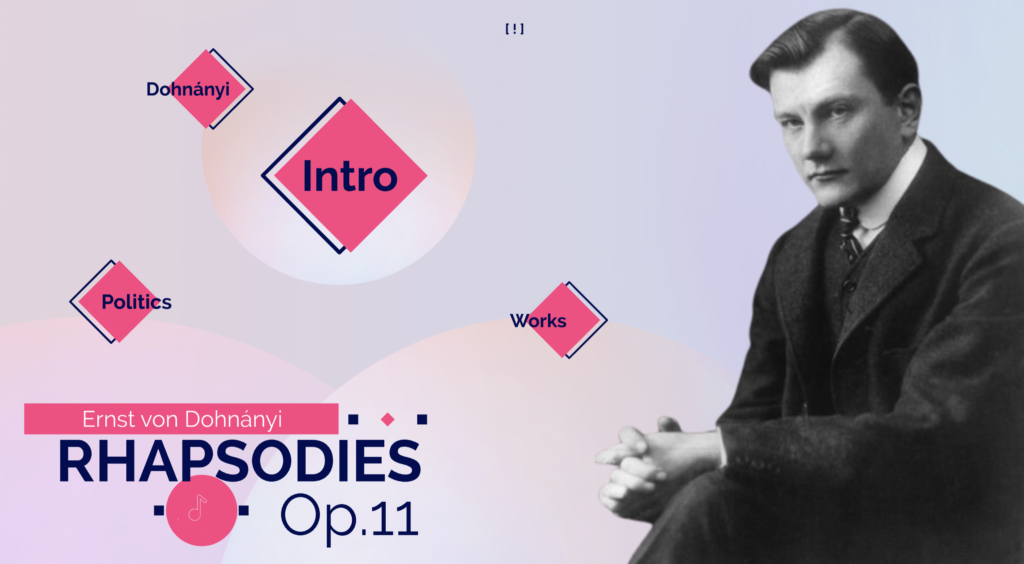Rhapsodies Op.11
The Legacy of Ernst von Dohnányi
Friday, April 12, 2024
PTFGR Presentation


Ernő Dohnányi (1877-1960), better known by his German name, Ernst von Dohnányi, was a Hungarian musician who contributed to world of music in many different ways. First and foremost, Dohnányi was a pianist. Dohnányi made his European debut at the age of 19 in Berlin. Dohnányi gave over fifteen hundred concerts in various countries, including United States, during the first thirty years of his career. He was extraordinary in skill and talent. Dohnányi was able to improvise concerto cadenzas on the concert stage and complete unfinished works during their premier performances. He was able to recall pieces performed decades earlier and could read, as well as transpose, from the orchestral score with ease. Dohnányi performed his re-debut concert in Carnegie Hall at the age of 76 and continued to perform and record until his death in 1960.
During his lifetime, Dohnányi held several important administrative posts which included the Director Budapest Royal Academy of Music (later renamed Liszt Academy) position, where he also served as the Head of the Piano Department. He was the Director of Hungarian Radio, Director of First International Liszt Piano Competition and the Conductor of Budapest Philharmonic. Besides Dohnányi’s administrative work, conducting, concertizing career and his prolific compositional oeuvre, he was able to maintain teaching as his principal source of employment. Dohnányi began teaching at the invitation of Joseph Joachim in Berlin, at the Hochschule fűr Music (1905 – 1916). Upon his return to Budapest, Dohnányi taught at the Academy until his exile in 1945. Some of his students include Annie Fischer, Edward Kilényi, Balint Vazsonyi, and György Solti. Dohnányi taught at the Florida State University from 1949 until his death in 1960.
Rhapsodies Op.11 (No.1 in g: Allegro Non Troppo, Ma Agitato, No.2 in f#: Adagio Capriccioso, No.3 in C: Vivace, No.4 in E- flat: Andante Lugubre) were composed in 1904 during Dohnányi’s brief residence in Vienna. Cyclical in nature, this work could be referred to as a Sonata: Fast, Slow, Scherzo and a Finale featuring Dies Irae. The original theme of Rhapsody #1 is not heard in its entirety until Rhapsody #4 when it is transposed to a major key and is juxtaposed with the triumphant Dies Irae. Dohnányi’s compositional style of these pieces reflects early influences during his years as a student.
Following the German Romantic tradition of Károly Goldmark and Ödön Mihalovich, Dohnányi remained in Hungary for his musical studies. Having received training at the Budapest Royal Academy of Music, Dohnányi studied piano with István Thomán, pupil of Franz Liszt. He studied composition with Hans Koessler, an admirer of Johannes Brahms. Stylistic influence of these composers, combined with harmonic preferences of late nineteenth century Romanticism defines Dohnányi as a composer and places him in the German Romantic tradition. Liszt’s orchestral writing along with elements of virtuosity influenced Dohnányi’s compositional style. Brahms’ use of counterpoint combined with two-against-three rhythms make way into Dohnányi’s Rhapsodies op.11. Dohnányi’s harmonic language consists of the constant use of dominant sonorities in leading tone tension, as seen in Wagner’s works.
Dohnányi’s association with the German musical style combined with the unfortunate political circumstances of Hungary during the first half of the twentieth century seriously disadvantaged Dohnányi as an artist. His compositional link to German culture made Dohnányi a plausible target of fascist sympathy. German Romantic tradition was regarded as pro-Nazi German tradition by the Communist regime of post WWII Hungary. Although Dohnányi was cleared of any false charges, rumors and accusations against Dohnányi had a lasting effect on his reputation and career.
As early as 1919, Dohnányi became the victim of criticism by the Hungarian government. Under Fascist rule, Dohnányi was dismissed from his post as the Director of the Academy because of his refusal to fire Jewish colleague Zoltán Kodaly. Unwilling to implement government induced pressures of Anti-Semitic laws in the Academy, Dohnányi disbanded the Budapest Philharmonic Orchestra, resigned from his post as the Director and left his country in 1944. Under the Russian rule in post WWII Hungary, Dohnányi continued to be falsely accused of signing pro-Nazi, anti-Semitic and anti-Communist documents. Even after his move to United States where he became piano and composition faculty at Florida State University, Dohnányi encountered concert cancellations and was unable to perform extensively until just several years before his death.
It was not until 1990, when Hungary dismissed original charges and posthumously awarded Dohnányi the Kossuth Prize (highest award granted to a citizen) that Dohnányi became celebrated in his country. In 2002, Dohnányi Archives were established by the Hungarian Minister of National Cultural Heritage with the Institute for Musicology of the Hungarian Academy of Sciences in Budapest. In United States, the Dohnányi Collection was established at Florida State University and an International Dohnányi Festival was held in 2002. Interest in Dohnányi’s life and music is reemerging in the twenty first century with the growing contributions to Dohnányi’s Archives by scholars and musicians alike. Dohnányi’s extensive multi-faceted input to the world of music is invaluable and should now be unveiled from behind the curtain of rumor and accusation.
Appointment Request
Please fill out the contact form below. I look forward to connecting with you!
